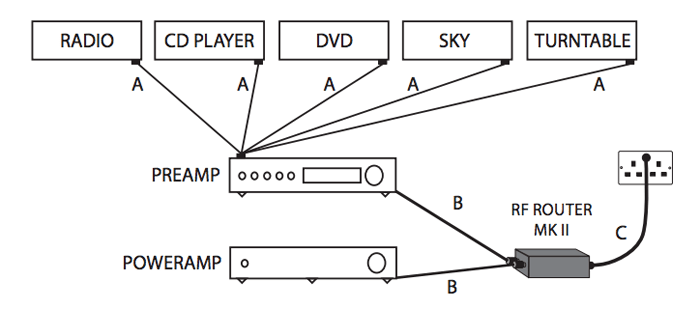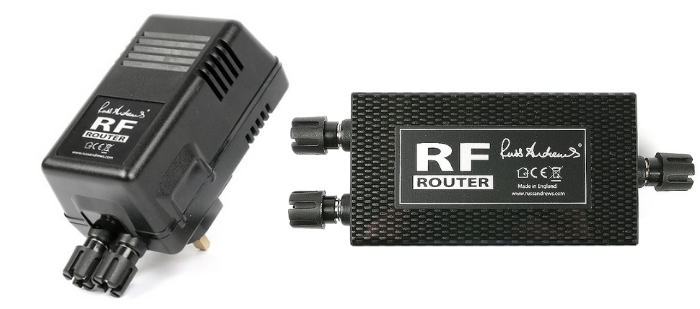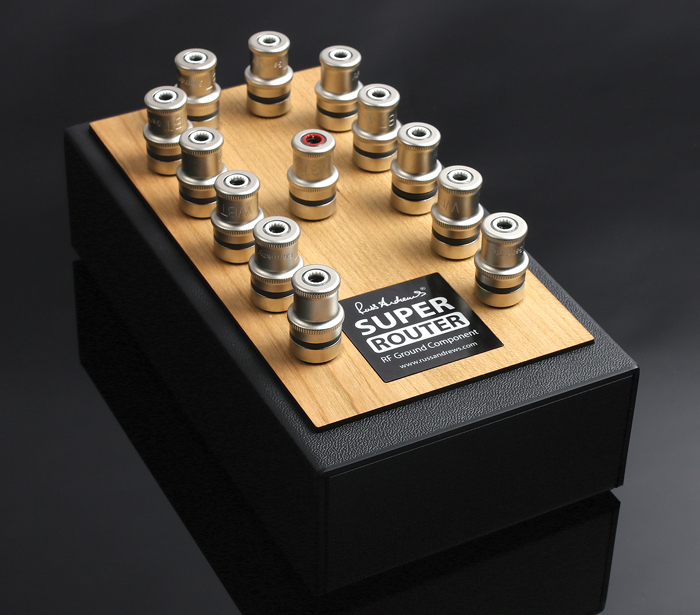Step 5 - Hi-Fi System Grounding.
Overview.
Over the past few years the market has become flooded with an aray of (often very expensive) grounding products, but the principle of providing an additional path to ground for RFI is nothing new. Russ began researching the benefits of RF grounding back in the 1970s, so we are in an unrivalled position when it comes to experience in this field.The result of Russ's continual R&D is a unique range of grounding products which offer an excellent way of removing sound-degrading RF (radio frequency) energy from your system. They work by offering an easy path to ground for RF noise, especially in the form of 'casework RF energy'.

In our experience, RF grounding gives a substantial improvement in the sound, with cleaner, deeper bass and a more stable soundstage. Casework grounding in paricular is very effective as, more often than not, the metal casework has a direct path to the signal ground on RCA and XLR sockets - meaning that we can add a very convenient and effecient route for RFI to travel out of the component.
Russ has produced some straightforward instructions to guide you through the process:
Click here to read our guide to Grounding your system
The RF Router - the heart of the grounding system
Grounding the metal casework on your system by running an earth cable - via one of our RF Routers - to an earth spike or earth terminal on your mains socket, can bring real sonic benefits.
Models shown: Plug-In RF Router and RF Router MkII.
The Routers work by efficiently separating off RF grounding, effectively 'dumping' high frequency noise out of your system. The internal circuitry is frequency optimised to provide an easy route for RFI to exit the equipment's chassis down to ground....... hence the name 'RF Router'.
Plug in and stand-alone models.
The simplest way of connecting your RF Router to earth is to use the earth in your mains wiring. We make this easy for you with the plug-in RF Router; this mounts the RF Router filter into a plug top that you simply plug into the mains and uses the earth pin to connect to earth. This approach uses up a socket, however.Another way of connecting to the mains earth is to fit one of our sockets with the grounding point on the front. You would then use our RF Router MkII and a wire to connect the output of the Router to the grounding terminal on the front of your socket.
Click here to view the Plug-In RF Router and here for the RF Router MkII
Click here to view the SuperRouter and here for the Signature Edition

Model shown: SuperRouter Signature Edition.
Obviously, this involves a bit of work in getting the cabling from inside to outside, so if it’s something you feel unsure about tackling yourself, speak to a friendly electrician or builder who would be able to do this for you.
Click here for the next step...
Click here to view the Plug-In RF Router and here for the RF Router MkII
The SuperRouter.
Introduced in 2021, the Super Router, and Super Router Signature Edition, are designed to be used in the same way as our existing RF Router MkII, but offer far greater performance due to their more complex design and superior componentry.Click here to view the SuperRouter and here for the Signature Edition

Model shown: SuperRouter Signature Edition.
Connecting via the mains earth.
The easiest way to connect your Russ Andrews Grounding System to ground is via the existing mains earth. This can be achieved either by the use of the Plug-in RF Router, which uses the earth pin to ground, or via one of the grounding terminals on our SuperSockets, UltraSockets or Signature Sockets.Connecting To An External Ground Rod.
For the very best performance, connect the output of our RF Router to ground via an earth rod. This is as straightforward as it sounds – a cable running from the output of the RF Router to a rod buried in the ground outside your house.Obviously, this involves a bit of work in getting the cabling from inside to outside, so if it’s something you feel unsure about tackling yourself, speak to a friendly electrician or builder who would be able to do this for you.
Technical Ground Weave.
When it comes to connecting all your kit to the RF Router and grounding points - whether via your mains earth of an earth rod - we have two levels of cables.Russ Andrews Technical Ground Weave
Technical Ground Weave is the preferred choice and has two keys advantages:- A heavy gauge, low inductance, low impedance Kimber cable with high purity copper conductors, providing an efficient path to ground for dumping RF from your system
- As with other Kimber Kable, Technical Ground Weave uses their unique woven geomerty to reject airbourne RFI being 'injected' back into the system.
Russ Andrews Premium Technical Ground Weave
- Premium Technical Ground Weave builds on the design of the standard version by the use of twice as many conductors (16 vs 8), higher purity copper and Teflon® rather than polyethylene insulation. The ultimate choice for best performance
Click here for the next step...






















